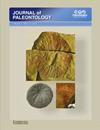First virtual endocast description of an early Miocene representative of Pan-Octodontoidea (Caviomorpha, Hystricognathi) and considerations on the early encephalic evolution in South American rodents
IF 1.6
4区 地球科学
Q3 PALEONTOLOGY
引用次数: 0
Abstract
Abstract. The study of the cranial endocast provides valuable information to understand the behavior of an organism because it coordinates sensory information and motor functions. In this work, we describe for the first time the anatomy of the encephalon of an early Miocene pan-octodontoid caviomorph rodent (Prospaniomys priscus Ameghino, 1902) found in the Argentinean Patagonia, based on a virtual 3D endocast. This fossil rodent has an endocast morphology here considered ancestral for Pan-Octodontoidea and other South American caviomorph lineages, i.e., an encephalon with anteroposteriorly aligned elements, mesencephalon dorsally exposed, well-developed vermis of the cerebellum, and rhombic cerebral hemispheres with well-developed temporal lobes. Prospaniomys Ameghino, 1902 also has relatively small olfactory bulbs, large paraflocculi of the cerebellum, and low endocranial volume and degree of neocorticalization. Its encephalization quotient is low compared with Paleogene North American and European noncaviomorph rodents, but slightly higher than in several late early and late Miocene caviomorphs. Paleoneurological anatomical information supports the hypothesis that Prospaniomys was a generalist caviomorph rodent with terrestrial habits and enhanced low-frequency auditory specializations. The scarce paleoneurological information indicates that several endocast characters in caviomorph rodents could change with ecological pressures. This work sheds light on the anatomy and evolution of several paleoneurological aspects of this particular group of South American rodents.首次对一个中新世早期泛八齿兽总科代表的虚拟内蕴描述及对南美啮齿动物早期脑进化的思考
摘要颅内腔的研究为理解生物体的行为提供了有价值的信息,因为它协调感觉信息和运动功能。在这项工作中,我们首次描述了在阿根廷巴塔哥尼亚发现的一种中新世早期的pan- octopus -类洞穴型啮齿动物(Prospaniomys priscus Ameghino, 1902)的脑结构,基于虚拟3D内胆模型。这种啮齿动物化石具有内嵌形态,这里被认为是泛八齿动物和其他南美洞穴形态谱系的祖先,即,具有前后对齐元素的脑,背向暴露的中脑,发育良好的小脑蚓,以及具有发育良好的颞叶的菱形大脑半球。Prospaniomys Ameghino, 1902也有相对较小的嗅球,小脑的小叶旁较大,颅内体积和新皮质化程度较低。与古近纪北美和欧洲的非洞穴型啮齿动物相比,其脑化商较低,但略高于早中新世晚期和晚中新世的一些洞穴型啮齿动物。古神经解剖学信息支持这样的假设,即Prospaniomys是一种具有陆地习性和增强的低频听觉特化的多面手穴形啮齿动物。缺乏的古神经学信息表明,穴型啮齿动物的一些内质特征可能随着生态压力而改变。这项工作揭示了这个特殊的南美啮齿动物群体的解剖学和进化的几个古神经学方面。
本文章由计算机程序翻译,如有差异,请以英文原文为准。
求助全文
约1分钟内获得全文
求助全文
来源期刊

Journal of Paleontology
地学-古生物学
CiteScore
2.80
自引率
7.10%
发文量
94
审稿时长
6-12 weeks
期刊介绍:
The Journal of Paleontology publishes original articles and notes on the systematics, phylogeny, paleoecology, paleogeography, and evolution of fossil organisms. It emphasizes specimen-based research and features high quality illustrations. All taxonomic groups are treated, including invertebrates, microfossils, plants, vertebrates, and ichnofossils.
 求助内容:
求助内容: 应助结果提醒方式:
应助结果提醒方式:


